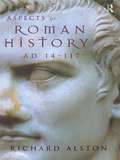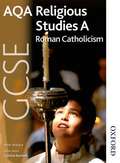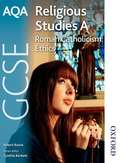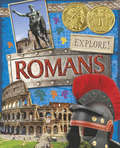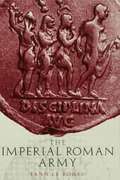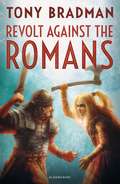Special Collections
Romans (rotten or not!)
Description: Images and books to support project and theme based learning on Roman history.
- Table View
- List View
Aspects Of Roman History, A. D. 14-117
by Richard AlstonAspects of Roman History AD14 117 charts the history of the Roman Imperial period, from the establishment of the Augustan principate to the reign of Trajan, providing a basic chronological framework of the main events and introductory outlines of the major issues of the period. The first half of the book outlines the linear development of the Roman Empire, emperor by emperor, accenting the military and political events. The second half of the book concentrates on important themes which apply to the period as a whole, such as the religious, economic and social functioning of the Roman Empire. It includes: a discussion of the primary sources of Roman Imperial history clearly laid out chapters on different themes of the Roman Empire such as patronage, religion, the role of the senate, the army and the position of women and slaves designed for easy cross-referencing with the chronological outline of events maps and illustrations a guide to further reading. Richard Alston's highly accessible book is designed specifically for students with little previous experience of studying ancient/Roman history. Aspects of Roman History provides an invaluable introduction to Roman Imperial history, which will allow students to gain an overview of the period and will be an indispensable aid to note-taking, essay preparation and examination revision. "
Aspects Of Roman History, A. D. 14-117 (PDF)
by Richard AlstonAspects of Roman History AD14 117 charts the history of the Roman Imperial period, from the establishment of the Augustan principate to the reign of Trajan, providing a basic chronological framework of the main events and introductory outlines of the major issues of the period. The first half of the book outlines the linear development of the Roman Empire, emperor by emperor, accenting the military and political events. The second half of the book concentrates on important themes which apply to the period as a whole, such as the religious, economic and social functioning of the Roman Empire. It includes: a discussion of the primary sources of Roman Imperial history clearly laid out chapters on different themes of the Roman Empire such as patronage, religion, the role of the senate, the army and the position of women and slaves designed for easy cross-referencing with the chronological outline of events maps and illustrations a guide to further reading. Richard Alston's highly accessible book is designed specifically for students with little previous experience of studying ancient/Roman history. Aspects of Roman History provides an invaluable introduction to Roman Imperial history, which will allow students to gain an overview of the period and will be an indispensable aid to note-taking, essay preparation and examination revision. "
AQA GCSE Religious Studies A
by Peter John Wallace and Cynthia BartlettWritten for the AQA GCSE Religious Studies A specification, the student book provides a focused look on individual religions. Key terms reinforce learning, providing definitions of key words that students need to be familiar with.
AQA Religious Studies A GCSE
by Bowie and Robert Bartlett and CynthiaSupporting the flexibility of the specification with the most extensive choice of resources! AQA GCSE Religious Studies is the only resource to be developed with and endorsed by AQA for the 2009 specification. Supporting 11 out of 14 topics, these books provide a fresh and focused look on individual religions.
Romans
by Jane BinghamLearn all about the mighty Romans with this brilliant photographic book. From the rise of Rome and the growth of the Roman Empire to the great emperors, such as Julius Caesar and Mark Antony. We look at the powerful Roman army and how the civilization spread across Europe. Find out how we know about the Romans today, from the amazing buildings that are still standing to the discovery of Pompeii and Herculaneum. Then take a look at Roman gods and godesses, and the entertainments, food, artists, musicians and medicines of the time.Read about the games that took place in great amphitheatres, such as the grand Colosseum, the gladiator fights and exciting chariot races. Then, learn about home and family life of people in ancient Rome. You can even read about a day in the life of a Roman child, and design and make your own mosaic with our brilliant activity page.Discover amazing facts about the Roman civilization!
Imperial Roman Army
by Yann Le BohecNow available in paperback, The Imperial Roman Army looks at the structure and development of the army between the Republic and the Late Empire, examining why the army has always been accorded such a prominent position in the history of the Roman Empire, and whether that view is justified. The book is divided into three sections. The author first examines the major divisions of army organization, the legions, the auxiliary units, the fleet and how the men were recruited. Secondly he looks at what the army did, their training, tactics and strategy. Finally he considers the historical role of the army and how it fitted into Roman society.
Imperial Roman Army (PDF)
by Yann Le BohecNow available in paperback, The Imperial Roman Army looks at the structure and development of the army between the Republic and the Late Empire, examining why the army has always been accorded such a prominent position in the history of the Roman Empire, and whether that view is justified. The book is divided into three sections. The author first examines the major divisions of army organization, the legions, the auxiliary units, the fleet and how the men were recruited. Secondly he looks at what the army did, their training, tactics and strategy. Finally he considers the historical role of the army and how it fitted into Roman society.
Map of the Roman Empire, circa 150AD (Large Print)
by Rnib BookshareThis map shows the extent of the Roman Empire at this time. It is surrounded by an image border, and the countries have been marked by abbreviated letters. These can be referenced in the key that runs along the bottom of the page. There is a locator dot shown, which will be at the top left of the page when the image is the right way up. In the top right corner of the page there is a north arrow. Within the image border the un-textured areas represent the sea. The Roman Empire dominates countries around the centre of the map and surrounds the Mediterranean Sea. The Roman Empire itself was surrounded by other lands, which include Europe across the top section of the image and North Africa along the bottom section.
Map of the Roman Empire, circa 150AD (UEB Contracted)
by Rnib BookshareThis map shows the extent of the Roman Empire at this time. It is surrounded by an image border, and the countries have been marked by abbreviated letters. These can be referenced in the key that runs along the bottom of the page. There is a locator dot shown, which will be at the top left of the page when the image is the right way up. In the top right corner of the page there is a north arrow. Within the image border the un-textured areas represent the sea. The Roman Empire dominates countries around the centre of the map and surrounds the Mediterranean Sea. The Roman Empire itself was surrounded by other lands, which include Europe across the top section of the image and North Africa along the bottom section.
Map of the Roman Empire, circa 150AD (UEB Uncontracted)
by Rnib BookshareThis map shows the extent of the Roman Empire at this time. It is surrounded by an image border, and the countries have been marked by abbreviated letters. These can be referenced in the key that runs along the bottom of the page. There is a locator dot shown, which will be at the top left of the page when the image is the right way up. In the top right corner of the page there is a north arrow. Within the image border the un-textured areas represent the sea. The Roman Empire dominates countries around the centre of the map and surrounds the Mediterranean Sea. The Roman Empire itself was surrounded by other lands, which include Europe across the top section of the image and North Africa along the bottom section.
Roman Chariot and horse (Large Print)
by Rnib BookshareThis image shows a side view of a horse harnessed to a chariot, which is being driven by a charioteer. The horse is on the right side of the page, with the chariot and charioteer on the left. There is a locator dot shown, which will be at the top left of the page when the image is the right way up. The horse is facing towards the right so only one ear, eye and nostril can be found. Its mouth is open and around its face it wears a bridle. Along the top of the horse's neck is its mane. At the base of the horse's neck, around its shoulders, is part of the harness of the chariot and the shaft which attaches to the chariot. Moving up from the shaft is the horse's body and tail, and moving down from the shaft are the horse's legs. This horse is trotting and is attached to the base of the chariot by the shaft to the left. In the bottom left of the image, one of the chariot's two wheels can be found. Up from this is the charioteer. He is heavily armoured. He holds both of his arms out in front of him towards the right and in his hand nearest the chariot he holds the horse's reins. These lead to the horses bridle. The charioteer's other hand is waving a whip. To the left is the charioteer's head, looking to the right, so only one eye can be found. He wears a metal helmet with decorative feathers along the top.
Roman Chariot and horse (UEB Contracted)
by Rnib BookshareThis image shows a side view of a horse harnessed to a chariot, which is being driven by a charioteer. The horse is on the right side of the page, with the chariot and charioteer on the left. There is a locator dot shown, which will be at the top left of the page when the image is the right way up. The horse is facing towards the right so only one ear, eye and nostril can be found. Its mouth is open and around its face it wears a bridle. Along the top of the horse's neck is its mane. At the base of the horse's neck, around its shoulders, is part of the harness of the chariot and the shaft which attaches to the chariot. Moving up from the shaft is the horse's body and tail, and moving down from the shaft are the horse's legs. This horse is trotting and is attached to the base of the chariot by the shaft to the left. In the bottom left of the image, one of the chariot's two wheels can be found. Up from this is the charioteer. He is heavily armoured. He holds both of his arms out in front of him towards the right and in his hand nearest the chariot he holds the horse's reins. These lead to the horses bridle. The charioteer's other hand is waving a whip. To the left is the charioteer's head, looking to the right, so only one eye can be found. He wears a metal helmet with decorative feathers along the top.
Roman Chariot and horse (UEB Uncontracted)
by Rnib BookshareThis image shows a side view of a horse harnessed to a chariot, which is being driven by a charioteer. The horse is on the right side of the page, with the chariot and charioteer on the left. There is a locator dot shown, which will be at the top left of the page when the image is the right way up. The horse is facing towards the right so only one ear, eye and nostril can be found. Its mouth is open and around its face it wears a bridle. Along the top of the horse's neck is its mane. At the base of the horse's neck, around its shoulders, is part of the harness of the chariot and the shaft which attaches to the chariot. Moving up from the shaft is the horse's body and tail, and moving down from the shaft are the horse's legs. This horse is trotting and is attached to the base of the chariot by the shaft to the left. In the bottom left of the image, one of the chariot's two wheels can be found. Up from this is the charioteer. He is heavily armoured. He holds both of his arms out in front of him towards the right and in his hand nearest the chariot he holds the horse's reins. These lead to the horses bridle. The charioteer's other hand is waving a whip. To the left is the charioteer's head, looking to the right, so only one eye can be found. He wears a metal helmet with decorative feathers along the top.
Roman citizens (Large Print)
by Rnib BookshareThis image shows male and female Roman citizens who wear similar clothing. Both of them are shown standing facing you. The man is on the left of the page and the woman on the right. There is a locator dot shown, which will be at the top left of the page when the image is the right way up. In the top left of the page is the man's head. He has short hair and stands smiling. Both of his arms can be found; his arm on the left side of the page hangs by his side and on the right he holds his other arm up high as if waving. He has a signet ring on this hand. He wears a tunic with a toga wrapping over his shoulders and around his body. He also wears leather sandals on his feet. On the top right of the page is the woman's head. Her hair is tied up in a bun, and she has a smiling face. A beaded necklace decorates her neck. Her arm to the left is held out to the side and her arm to the right is held out at an angle, showing her bangle. Her palla wraps over her shoulders and drapes around her stola, held in place by a brooch. Her stola is long and reaches her ankles. On her feet she wears leather sandals.
Roman Foot Soldier and Officer (UEB Contracted)
by Rnib BookshareThis image shows a Roman foot soldier on the left of the page and an officer on the right. Both of them are standing facing you. There is a locator dot shown, which will be at the top left of the page when the image is the right way up. In the top left corner of the page the foot soldier wears a metal helmet. He has a smiling face. Moving down, he wears some light armour over a tunic. In his hand on the left side of the page he holds a very long spear, with the sharp spearhead at the top. His sword hangs to the left of his body from his waist. His hand on his right is obscured by an oval shield. His tunic reaches his knees and he wears strapped leather sandals on his feet. The officer stands on the right side of the page. In the top right corner is the officer's helmet, with a large feather plume on top. He also has a smiling face. Down the page he wears a metal breastplate and to the left of this his shoulder is draped with a cloak. His arm hangs by his side. His sword also hangs to the left of his body. On his other side his hand is obscured, as he is holding a very large shield. He also has a knee length tunic, but in addition he wears protective shin armour on his legs. Like the foot soldier, he wears leather sandals on his feet.
Roman Merchant Ship, circa 100AD (Large Print)
by Rnib BookshareThis diagram shows a Roman merchant ship with full sails, castle, hull and foremast. The bow of the ship is on the right of the page and the stern on the left. There is a locator dot shown, which will be at the top left of the page when the image is the right way up. In the top centre of the image is the mast with two triangular shaped sails on either side. Down the image is a large full sail and the bottom of the mast. The hull of the ship is at the bottom of the page. On the left side of the hull is the elaborately decorated stern. Slightly towards the right is the castle, which is a cabin-like structure. Down is the large steering oar. Right along the hull of the boat is the bow and up from this, the small foremast with a sail. On the left and right side of the hull is a dashed line which represents the water level, showing how far the boat sits in the water.
Roman Merchant Ship, circa 100AD (UEB Contracted)
by Rnib BookshareThis diagram shows a Roman merchant ship with full sails, castle, hull and foremast. The bow of the ship is on the right of the page and the stern on the left. There is a locator dot shown, which will be at the top left of the page when the image is the right way up. In the top centre of the image is the mast with two triangular shaped sails on either side. Down the image is a large full sail and the bottom of the mast. The hull of the ship is at the bottom of the page. On the left side of the hull is the elaborately decorated stern. Slightly towards the right is the castle, which is a cabin-like structure. Down is the large steering oar. Right along the hull of the boat is the bow and up from this, the small foremast with a sail. On the left and right side of the hull is a dashed line which represents the water level, showing how far the boat sits in the water.
Roman Merchant Ship, circa 100AD (UEB Uncontracted)
by Rnib BookshareThis diagram shows a Roman merchant ship with full sails, castle, hull and foremast. The bow of the ship is on the right of the page and the stern on the left. There is a locator dot shown, which will be at the top left of the page when the image is the right way up. In the top centre of the image is the mast with two triangular shaped sails on either side. Down the image is a large full sail and the bottom of the mast. The hull of the ship is at the bottom of the page. On the left side of the hull is the elaborately decorated stern. Slightly towards the right is the castle, which is a cabin-like structure. Down is the large steering oar. Right along the hull of the boat is the bow and up from this, the small foremast with a sail. On the left and right side of the hull is a dashed line which represents the water level, showing how far the boat sits in the water.
Roman mosaic
by Rnib BookshareThis image shows a diagram of a mosaic and a diagram of a detail of the mosaic. There is a locator dot shown, which will be at the top left of the page when the image is the correct way up. There is the complete but simplified mosaic on the left of the page and a detail showing the tiles that make up part of the mosaic on the right of the page. A traditional Roman mosaic is made of a great number of differently coloured tile fragments. In the image on the right the tiles are shown significantly larger than in real life so it will work tactually. The diagram on the left shows an image of a duck seen from the side facing left, both legs can be found but only one eye and wing is shown. It is surrounded by decorative fronds and vine leaves. The ducks head is towards the top left of the image with the beak pointing left and down. From the head the neck curves down and left to the body. At the base of the neck there is a part ring of white. In the centre of the body a bolder line that curves down and right represents the wing. Towards the tail on the right there is a patch of paler colour. Down from the body are the two legs and wide feet. On the left of the image is an area representing leaves. From them come curling tendrils in two shades of green - dashed and solid lines. To the right of the ducks head is a circular flower head. It has various rings of colour getting smaller to the centre. A wiggly stem goes down and right to the edge of the image. Halfway along it has a leaf up and down from the stem. At the bottom right are more vine leaves and one decorative frond. A line of very dark green tiles surrounds the image. At the top and bottom these are two tiles wide. An image border surrounds the image on the right. Most of the image is the duck enlarged from the image on the left. The duck fills the centre of the image and is shown in tiles, mainly a green colour. The ducks head is in the top left of the image with the beak pointing left and down. The beak is made from red-brown tiles. In the centre of the head is an eye made from a single dark blue tile. It is surrounded by white tiles. From the head the neck curves down and left to the body. At the base of the neck there is a part ring of white fringed with very dark blue tiles above and below it. In the centre of the body a bolder line of tiles that curves down and right represents the wing. At the start of this line up and down the page are pale yellow-green tiles. Towards the tail on the right there is a patch of paler coloured tiles. The breast of the bird is in red-brown tiles. Down from the body are the two legs and wide feet. The one to the left is of green tiles but the one to the right is of red-brown tiles. In the top right of the image is the flower head. In the centre is a dark brown tile surrounded by four white tiles. Pale yellow green tiles surround this. The outer edge of the flower head is a ring of alternating red-brown and white tiles. A line of dark green tiles goes from the bottom right of the flower head to the centre right of the image, these represent the flower stem. Dark green tiles up and down from this represent parts of leaves. The background to the image, surrounding the duck and flower, is a mass of small ivory coloured tiles. For clarity these are not shown. The mosaic dates from the 3rd to 5th century. It was found in Tunis, Tunisia. The artist is unknown.
Roman mosaic
by Rnib BookshareThis image shows a diagram of a mosaic and a diagram of a detail of the mosaic. There is a locator dot shown, which will be at the top left of the page when the image is the correct way up. There is the complete but simplified mosaic on the left of the page and a detail showing the tiles that make up part of the mosaic on the right of the page. A traditional Roman mosaic is made of a great number of differently coloured tile fragments. In the image on the right the tiles are shown significantly larger than in real life so it will work tactually. The diagram on the left shows an image of a duck seen from the side facing left, both legs can be found but only one eye and wing is shown. It is surrounded by decorative fronds and vine leaves. The ducks head is towards the top left of the image with the beak pointing left and down. From the head the neck curves down and left to the body. At the base of the neck there is a part ring of white. In the centre of the body a bolder line that curves down and right represents the wing. Towards the tail on the right there is a patch of paler colour. Down from the body are the two legs and wide feet. On the left of the image is an area representing leaves. From them come curling tendrils in two shades of green - dashed and solid lines. To the right of the ducks head is a circular flower head. It has various rings of colour getting smaller to the centre. A wiggly stem goes down and right to the edge of the image. Halfway along it has a leaf up and down from the stem. At the bottom right are more vine leaves and one decorative frond. A line of very dark green tiles surrounds the image. At the top and bottom these are two tiles wide. An image border surrounds the image on the right. Most of the image is the duck enlarged from the image on the left. The duck fills the centre of the image and is shown in tiles, mainly a green colour. The ducks head is in the top left of the image with the beak pointing left and down. The beak is made from red-brown tiles. In the centre of the head is an eye made from a single dark blue tile. It is surrounded by white tiles. From the head the neck curves down and left to the body. At the base of the neck there is a part ring of white fringed with very dark blue tiles above and below it. In the centre of the body a bolder line of tiles that curves down and right represents the wing. At the start of this line up and down the page are pale yellow-green tiles. Towards the tail on the right there is a patch of paler coloured tiles. The breast of the bird is in red-brown tiles. Down from the body are the two legs and wide feet. The one to the left is of green tiles but the one to the right is of red-brown tiles. In the top right of the image is the flower head. In the centre is a dark brown tile surrounded by four white tiles. Pale yellow green tiles surround this. The outer edge of the flower head is a ring of alternating red-brown and white tiles. A line of dark green tiles goes from the bottom right of the flower head to the centre right of the image, these represent the flower stem. Dark green tiles up and down from this represent parts of leaves. The background to the image, surrounding the duck and flower, is a mass of small ivory coloured tiles. For clarity these are not shown. The mosaic dates from the 3rd to 5th century. It was found in Tunis, Tunisia. The artist is unknown.
Roman mosaic
by Rnib BookshareThis image shows a diagram of a mosaic and a diagram of a detail of the mosaic. There is a locator dot shown, which will be at the top left of the page when the image is the correct way up. There is the complete but simplified mosaic on the left of the page and a detail showing the tiles that make up part of the mosaic on the right of the page. A traditional Roman mosaic is made of a great number of differently coloured tile fragments. In the image on the right the tiles are shown significantly larger than in real life so it will work tactually. The diagram on the left shows an image of a duck seen from the side facing left, both legs can be found but only one eye and wing is shown. It is surrounded by decorative fronds and vine leaves. The ducks head is towards the top left of the image with the beak pointing left and down. From the head the neck curves down and left to the body. At the base of the neck there is a part ring of white. In the centre of the body a bolder line that curves down and right represents the wing. Towards the tail on the right there is a patch of paler colour. Down from the body are the two legs and wide feet. On the left of the image is an area representing leaves. From them come curling tendrils in two shades of green - dashed and solid lines. To the right of the ducks head is a circular flower head. It has various rings of colour getting smaller to the centre. A wiggly stem goes down and right to the edge of the image. Halfway along it has a leaf up and down from the stem. At the bottom right are more vine leaves and one decorative frond. A line of very dark green tiles surrounds the image. At the top and bottom these are two tiles wide. An image border surrounds the image on the right. Most of the image is the duck enlarged from the image on the left. The duck fills the centre of the image and is shown in tiles, mainly a green colour. The ducks head is in the top left of the image with the beak pointing left and down. The beak is made from red-brown tiles. In the centre of the head is an eye made from a single dark blue tile. It is surrounded by white tiles. From the head the neck curves down and left to the body. At the base of the neck there is a part ring of white fringed with very dark blue tiles above and below it. In the centre of the body a bolder line of tiles that curves down and right represents the wing. At the start of this line up and down the page are pale yellow-green tiles. Towards the tail on the right there is a patch of paler coloured tiles. The breast of the bird is in red-brown tiles. Down from the body are the two legs and wide feet. The one to the left is of green tiles but the one to the right is of red-brown tiles. In the top right of the image is the flower head. In the centre is a dark brown tile surrounded by four white tiles. Pale yellow green tiles surround this. The outer edge of the flower head is a ring of alternating red-brown and white tiles. A line of dark green tiles goes from the bottom right of the flower head to the centre right of the image, these represent the flower stem. Dark green tiles up and down from this represent parts of leaves. The background to the image, surrounding the duck and flower, is a mass of small ivory coloured tiles. For clarity these are not shown. The mosaic dates from the 3rd to 5th century. It was found in Tunis, Tunisia. The artist is unknown.
Roman road - cross section (Large Print)
by Rnib BookshareAn image border surrounds this image of a cross section of a Roman road, with a key explaining what the different lines represent, at the bottom of the page. There is a locator dot shown, which will be at the top left of the page when the image is the right way up. On the far left and far right side of the page, normal ground soil is shown, and in the centre of the image, four horizontal layers of material which make up the road. On the left and right side of the top layer are drainage ditches, which the water run-off from the road would drain into.
Roman road - cross section (UEB Contracted)
by Rnib BookshareAn image border surrounds this image of a cross section of a Roman road, with a key explaining what the different lines represent, at the bottom of the page. There is a locator dot shown, which will be at the top left of the page when the image is the right way up. On the far left and far right side of the page, normal ground soil is shown, and in the centre of the image, four horizontal layers of material which make up the road. On the left and right side of the top layer are drainage ditches, which the water run-off from the road would drain into.
Roman road - cross section (UEB Uncontracted)
by Rnib BookshareAn image border surrounds this image of a cross section of a Roman road, with a key explaining what the different lines represent, at the bottom of the page. There is a locator dot shown, which will be at the top left of the page when the image is the right way up. On the far left and far right side of the page, normal ground soil is shown, and in the centre of the image, four horizontal layers of material which make up the road. On the left and right side of the top layer are drainage ditches, which the water run-off from the road would drain into.
Revolt Against the Romans
by Tony Bradman"I've fought every kind of barbarian, but the Britons are by far the worst..."Marcus is excited about travelling to Britannia, the island at the edge of the world. But the Britons are savages who tattoo themselves and take the heads of their enemies in battle. They won't bow down to the rule of Rome. As Marcus travels to meet his father he meets a barbarian chief instead and his destiny is changed forever, along with that of Britannia...
